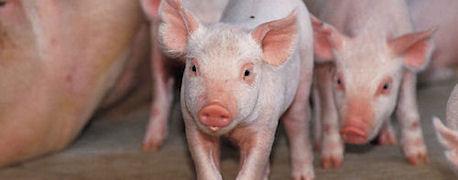
A detailed annotation of the genome of T.J. Tabasco, a pig from the University of Illinois South Farms, is the outcome of over 10 years of work by an international consortium.
It is expected to speed progress in both biomedical and agricultural research. U of I Vice President for Research Lawrence Schook says the College of Agricultural, Consumer and Environmental Sciences played a crucial role in getting the work started.
In 2001, Schook told ACES Dean Robert Easter the USDA was getting well positioned to do this kind of research.
"I told him we've got to get ready," Schook says. "Bob said, 'What do we need to do to help you?'"
The USDA, however, was initially unenthusiastic, saying that they did not want to fund a series of individual efforts. Funding that came through ACES allowed Schook and others to put together the Swine Genome Sequencing Consortium, an alliance of university, industry, and government laboratories in the U.S., Europe, and Asia. The USDA was impressed and committed 10 million dollars to the project.
Thanks to efforts by Easter and ACES Director of Planning and Research development Richard Vogen, the U of I received further funding from a federal earmark.
"It supported building some of the basic components like the maps and things that allowed the University of Illinois to partner with international labs," Schook adds. "It was really touted as the exemplar of earmarks because we weren't using it to support our own day-to-day work, we were really using it to support foundational research and development."
The consortium initially included labs in Korea, Japan, Illinois, and Iowa State. Groups at the Sanger Institute in the U.K., Wageningen University in the Netherlands, and the Institut National de la Recherche Agronomique (INRA) in France joined later. Today the project includes scientists from more than 50 research groups.
Schook says the project has three main objectives: (1) to serve as a blueprint for understanding evolution and domestication, (2) to advance research on animal production and health, and (3) to explore ways to use the pig in biomedical applications.
The first publication, which just appeared in Nature, focuses on the pig's evolution. Researchers compared the reference genome from T.J. Tabasco with genomes of wild and domestic pigs from Europe and Asia (including archaeological and museum samples), and to human, mouse, dog, horse, and cow genomes.
"The pig is interesting because the wild boar still exists," Schook explains. "We could look at domestication, and we also looked at speciation. From an evolutionary perspective, these Sus species diverge in a very short time."
The researchers traced the domestic pig back to Southeast Asia. From there, it spread across Eurasia. The glaciation period separated the pigs into two groups about one million years ago. Today they are almost sub-species. "However, their chromosome structures have stayed very similar," Schook notes.
Pigs were independently domesticated in western Eurasia and East Asia 10,000 to 15,000 years ago. There is evidence that as the early European settlers moved around, they bred the domesticated females with wild boars.
Pigs in Central and South America are thought to have originated on the Iberian Peninsula. In a paper soon to be published in Heredity, the researchers tracked how these pigs adapted to different climates, altitudes, and diets.
As well as providing insights into how the pig evolved, the genome sequencing provides valuable new tools for animal breeding. One is a DNA test that can identify individual pigs that are less susceptible to certain diseases or have a genetic predisposition to fattening rapidly, eating less, and bearing many offspring.
On the biomedical side, researchers will build on ongoing efforts to use the pig to model human diseases, including lifestyle diseases such as obesity, diabetes, and cardiovascular disease. The sequencing identified 112 genes in pigs that are also responsible for diseases in people, suggesting that pigs could be used for drug testing.
Another direction is to use pigs as a source of organs for humans. Schook mentions islet cells for diabetics as an example.
"Human transplant of islets doesn't work because there's not enough cells in a single pancreas," he explains. "If you could have an animal source, even if they get rejected, they're plentiful."
Clearly, there are a plenitude of exciting possibilities for future research. "For me, the next phase is looking at this concept of epigenomics–of how the environment affects gene expression," Schook said.
Other U of I researchers involved in the project are: Jon Beever, Laurie Rund, Sandra Rodriguez-Zas, Bruce Southy, and Jonathan Sweedler. Harris Lewin and Denis Larkin, who have left the U of I, are also part of the project.
Read the original article here.
